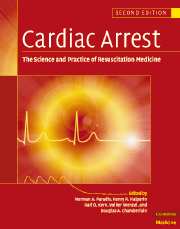Book contents
- Frontmatter
- Contents
- List of contributors
- Foreword
- Preface
- Part I Introduction
- Part II Basic science
- Part III The pathophysiology of global ischemia and reperfusion
- 12 The etiology of sudden death
- 13 Global brain ischemia and reperfusion
- 14 Reperfusion injury in cardiac arrest and cardiopulmonary resuscitation
- 15 Visceral organ ischemia and reperfusion in cardiac arrest
- 16 Mechanisms of forward flow during external chest compression
- 17 Hemodynamics of cardiac arrest
- 18 Coronary perfusion pressure during cardiopulmonary resuscitation
- 19 Methods to improve cerebral blood flow and neurological outcome after cardiac arrest
- 20 Pharmacology of cardiac arrest and reperfusion
- 21 Analysis and predictive value of the ventricular fibrillation waveform
- 22 Etiology, electrophysiology, and myocardial mechanics of pulseless electrical activity
- Part IV Therapy of sudden death
- Part V Postresuscitation disease and its care
- Part VI Special resuscitation circumstances
- Part VII Special issues in resuscitation
- Index
19 - Methods to improve cerebral blood flow and neurological outcome after cardiac arrest
from Part III - The pathophysiology of global ischemia and reperfusion
Published online by Cambridge University Press: 06 January 2010
- Frontmatter
- Contents
- List of contributors
- Foreword
- Preface
- Part I Introduction
- Part II Basic science
- Part III The pathophysiology of global ischemia and reperfusion
- 12 The etiology of sudden death
- 13 Global brain ischemia and reperfusion
- 14 Reperfusion injury in cardiac arrest and cardiopulmonary resuscitation
- 15 Visceral organ ischemia and reperfusion in cardiac arrest
- 16 Mechanisms of forward flow during external chest compression
- 17 Hemodynamics of cardiac arrest
- 18 Coronary perfusion pressure during cardiopulmonary resuscitation
- 19 Methods to improve cerebral blood flow and neurological outcome after cardiac arrest
- 20 Pharmacology of cardiac arrest and reperfusion
- 21 Analysis and predictive value of the ventricular fibrillation waveform
- 22 Etiology, electrophysiology, and myocardial mechanics of pulseless electrical activity
- Part IV Therapy of sudden death
- Part V Postresuscitation disease and its care
- Part VI Special resuscitation circumstances
- Part VII Special issues in resuscitation
- Index
Summary
Ischemic neurological injury accounts for much of the mortality and most of the morbidity among persons who are initially resuscitated from cardiac arrest. This chapter summarizes what is known about the determinants of cerebral blood flow during cardiopulmonary resuscitation (CPR) and the relationship of cerebral blood flow to neurological outcome.
Cerebral perfusion in the intact circulation has been characterized as a classical vascular waterfall. Arterial pressure is the upstream pressure, and cerebrospinal fluid pressure is the downstream pressure. Pressure in the venous sinuses is below the downstream pressure; that is, animal studies demonstrate a significant pressure gradient between the cortical veins and the sagittal sinus.
Determinants of cerebral blood flow
Halperin et al. reported a close correlation (r=0.89) between cerebral blood flow and the difference between carotid arterial pressure and pressure in the lateral ventricle during CPR in dogs. Accordingly, the determinants of carotid arterial pressure and intracranial cerebrospinal fluid pressure will be reviewed.
At the outset of CPR in laboratory animals, carotid artery pressure is usually equal to thoracic aortic pressure. As time goes by, however, carotid arterial pressure tends to fall, and cerebral blood flow declines in parallel. This phenomenon, termed carotid collapse, appears to be mediated by loss of vascular tone and physical collapse of the carotid artery at the thoracic inlet. α-Adrenergic agents and pressor doses of adrenalin reverse carotid collapse, in part by increasing the rigidity of the carotid artery and in part by raising peripheral resistance, thus limiting the runoff of blood to non-essential vascular beds. In animal studies, if CPR is begun immediately after the onset of cardiac arrest, carotid pressure remains as high as thoracic aortic pressure over periods of 1 hour or more as long as peripheral resistance is maximized.
- Type
- Chapter
- Information
- Cardiac ArrestThe Science and Practice of Resuscitation Medicine, pp. 389 - 394Publisher: Cambridge University PressPrint publication year: 2007

